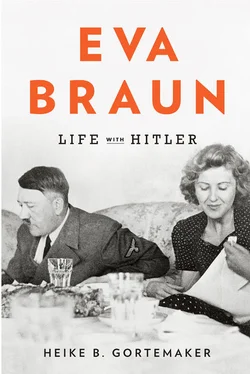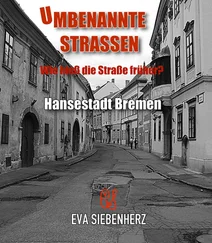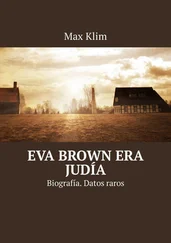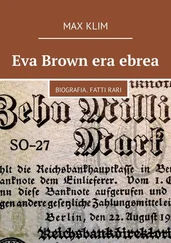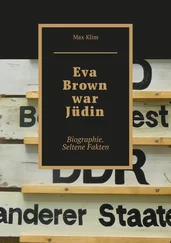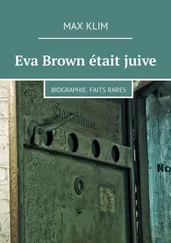261. See Hamann, Hitlers Wien , p. 15; Fest, Hitler, p. 726.
262. See Speer, Inside the Third Reich , pp. 99–100; cf. pp. 297–298, where Speer says: “in those days, I suspect, all that was mere coquettishness.” See also Speer, Albert Speer: Die Kransberg-Protokolle 1945 , pp. 112f. Speer thought at the time that Hitler wanted to retire after the war, since he was “not happy with his mission” and would “rather be an architect.” Nicolaus von Below, who stayed with Hitler at the Berghof in both April and August 1938, mentions nothing of this sort (see Below, Als Hitlers Adjutant , pp. 112ff.).
263. See Fest, Die unbeantwortbaren Fragen , p. 52. Cf. Speer, Inside the Third Reich , p. 99, where he says that “the design for the picture gallery and the stadium was to be assigned to me.”
264. Photographs of Roderich Fick and Albert Speer’s visit to the Berghof on May 9, 1939, are in Heinrich Hoffmann Photo Archive, hoff-25259, BSB Munich.
265. See Ingo Sarlay, “Hitlers Linz: Planungsstellen und Planungskonzepte,” http://www.linz09.info. See also Below, Als Hitlers Adjutant , pp. 81 and 83; Michael Früchtel, Der Architekt Hermann Giesler: Leben und Werk (1898–1987) (Tübingen, 2008); Hermann Giesler, Ein anderer Hitler: Bericht seines Architekten Hermann Giesler , 2nd ed. (Leoni am Starnberger See, 1977), pp. 213ff.
266. See Giesler, Ein anderer Hitler , p. 406.
267. See Hubert Houben, Kaiser Friedrich II: Herrscher, Mensch, und Mythos (Stuttgart, 2008); Karl Ipser, Der Staufer Friedrich II: Heimlicher Kaiser der Deutschen (Berg, 1977), pp. 144ff. and 214ff.
268. See Oskar Hugo Gugg, Castel del Monte (1942), oil on board, German Historical Museum, Berlin. See also Ipser, Der Staufer Friedrich II , p. 230.
269. Giesler, Ein anderer Hitler , pp. 213ff.
270. Ibid., p. 407. On April 4, 1943 Hitler traveled with Giesler, Speer, Fick, Eigruber, Karl Brandt, Heinrich Hoffmann, and Bormann to Linz, to review the progress of the project. See Heinrich Hoffmann Photo Archive, hoff-47460, BSB Munich.
271. See Henriette von Schirach, Frauen um Hitler , p. 233.
272. See Fest, Die unbeantwortbaren Fragen , p. 183.
9. ISOLATION DURING THE WAR
1. Adolf Hitler, Mein Kampf , 173rd ed. (Munich, 1936), pp. 732 and 742. See also Christian Zentner, Adolf Hitlers Mein Kampf: Eine kommentierte Auswahl , 19th ed. (Berlin, 2007), pp. 131f.
2. See the minutes of army adjutant Colonel Friedrich Hossbach, printed in Thilo Vogelsang, “Neue Dokumente zur Geschichte der Reichswehr, 1930–1933,” Vierteljahrshefte für Zeitgeschichte 4 (1954), pp. 434f.; Andreas Wirsching, “ ‘Man kann nur den Boden germanisieren’: Eine neue Quelle zu Hitlers Rede vor den Spitzen der Reichswehr am 3. Februar 1933,” Vierteljahrshefte für Zeitgeschichte , 49 (2001), pp. 518f. 526ff., and 540ff.; Kershaw, Hitler 1889–1936 , pp. 559ff.
3. See Friedrich Hossbach, “Niederschrift über die Besprechung in der Reichskanzlei am 5. November 1937, Berlin, 10. November 1937,” in Bernd-Jürgen Wendt, Grossdeutschland: Aussenpolitik und Kriegsvorbereitung des Hitlerregimes (Munich, 1987); Kershaw, Hitler 1936–1945 , p. 60.
4. See Goebbels, diary entry, February 3, 1939, in Die Tagebücher von Joseph Goebbels , Teil 1, vol. 6 (Munich, 1998), p. 247.
5. See Reuth, Goebbels , pp. 395f.
6. “Hitlers Rede vor Truppenkommandeuren am 10. Februar 1939,” in Klaus-Jürgen Müller, Armee und Drittes Reich 1933–1939 (Paderborn, 1987), pp. 365ff.
7. Below, Als Hitlers Adjutant , p. 147.
8. Adolf Hitler, “Rede vor dem Reichstag am 30. Januar 1939,” in Verhandlungen des Reichstags, 4. Wahlperiode 1939, Band 460. Stenographische Berichte 1939–1942. 1. Sitzung, Montag, 30. Januar 1939, pp. 1–21 .
9. Below, Als Hitlers Adjutant , p. 147.
10. See Sereny, Albert Speer , p. 236.
11. Speer, Inside the Third Reich , p. 130; Gun, Eva Braun , p. 173; Breloer, Unterwegs zur Familie Speer , p. 96. Speer’s oldest son showed Breloer a chest with snapshots and architectural photographs including images of “Eva Braun Furniture” and “Old Chancellery, Eva Braun’s Ladies’ Room, Living Room, and Bedroom.”
12. Speer, Inside the Third Reich , p. 102. Cf. Speer, Albert Speer: Die Kransberg-Protokolle 1945 , pp. 223f.; Kellerhoff, Hitlers Berlin, pp. 132f.; Dietmar Arnold, Reichskanzlei und “Führerbunker”: Legenden und Wirklichkeit (Berlin, 2006), pp. 69ff.
13. Speer, Inside the Third Reich , p. 130. It says there that Eva Braun’s bedroom was located next to Hitler’s. See also Gun, Eva Braun . “Room and boudoir communicated with Hitler’s library.” Eva Braun is there said to have entered her room “through the servants’ entrance,” since “officially her position was [as] one of the numerous secretaries in the offices.” Christa Schroeder, very familiar with the “Führer household” in the Old Chancellery since 1933, due to her “on-call duties,” stated that Hitler’s “work room, library, and bedroom, and later Eva Braun’s apartment next door” were located there ( Er war mein Chef , pp. 60f.).
14. “More About Evi,” Time , December 18, 1939. See also “Hitler’s Girl Evi Braun Takes His Picture,” Life , November 6, 1939; Richard Norburt, “Is Hitler Married?” Saturday Evening Post , December 16, 1939.
15. “Spring in the Axis,” Time , May 15, 1939. It says there: “To her friends Eva Braun confided that she expected her friend to marry her within a year.”
16. Bella Fromm, Blood & Banquets: A Berlin Social Diary (New York, 1990 [1st ed., London, 1943]), pp. 255 and 303. Bella Steuerman Fromm wrote for Ullstein Verlag (including for B.Z. Am Mittag ) and The Times (London) since the mid-1920s. Her contacts extended all the way to Schleicher and Papen. See Stephan Malinowski, Vom König zum Führer: Deutscher Adel und Nationalsozialismus (Berlin, 2003), p. 556; also Louis P. Lochner, Always the Unexpected: A Book of Reminiscences (New York, 1956). Another source for such inside information was Sigrid Schultz (pseudonym “John Dickson”), Berlin correspondent for the Chicago Daily Tribune, who knew Hermann Göring personally and interviewed Hitler many times. On the monitoring and censorship of foreign reporters, see Peter Longerich, Propagandisten im Krieg: Die Presseabteilung des Auswärtigen Amtes unter Ribbentrop (Munich, 1987), pp. 290ff.
17. See “Weisung des Führers und Obersten Befehlshabers der Wehrmacht, Geheime Kommandosache, Berlin, 21. Oktober 1938,” in Michael Freund, Weltgeschichte der Gegenwart in Dokumenten: Geschichte des Zweiten Weltkrieges , vol. 1 (Freiburg, 1954), pp. 302ff.
18. See Kershaw, Hitler 1936–1945 , p. 172.
19. See Rainerf Schmidt, Der Zweite Weltkrieg: Die Zerstörung Europas (Berlin, 2008), p. 13.
20. See Hans-Ulrich Thamer, Der Nationalsozialismus , pp. 319ff.
21. See Below, Als Hitlers Adjutant , pp. 169f.
22. Below, Als Hitlers Adjutant , p. 169. The circle around Hitler was thus neither “unsuspecting” nor “morally indifferent to his real plans,” as Sereny writes in her biography of Speer ( Albert Speer , p. 223).
23. See Speer, Albert Speer: Die Kransberg-Protokolle 1945 , pp. 224f. and 227. While the “negotiations with Russia progressed,” Speer claimed at that point, there were “vague rumors” on the Obersalzberg “that something was going on with Russia” (p. 227). In Inside the Third Reich , p. 162, Speer writes that Hitler had already, for “weeks before” in “long talks with his four military adjutants tried to arrive at definite plans.” In the German edition of his memoir, Speer specifies that talks “often went on for hours” [ Erinnerungen , pp. 176–177]—“Hitler tried to arrive at definite plans.” See also Kershaw, Hitler 1936–1945, pp. 283 and 290: Speer, according to Kershaw, “did not discuss foreign-policy details” with Hitler. See also Lars Lüdicke, Griff nach der Weltherrschaft: Die Aussenpolitik des Dritten Reiches 1933–1945 (Berlin, 2009), pp. 124f.
Читать дальше
